DSP&P Passenger Car Research
1234















1234
|
This post was updated on .
Just joined and am looking forward to chatting with you folks. I “model” the DSP&P in G Scale and am not super (any:) critical about being accurate. However, I have been trying to find some information related to passenger cars and decided I should ask here:
1. Can anyone provide some information on “Observation,” “Open Air,” or (even as I see in Poor’s Pictorial Supplement) “Rubber Neck” cars? That whole concept intrigues me, particularly in such a rugged, and likely cold, area as Colorado. I’m curious how these were outfitted and used as I see many photos with at least one or two at the end of a passenger consist. 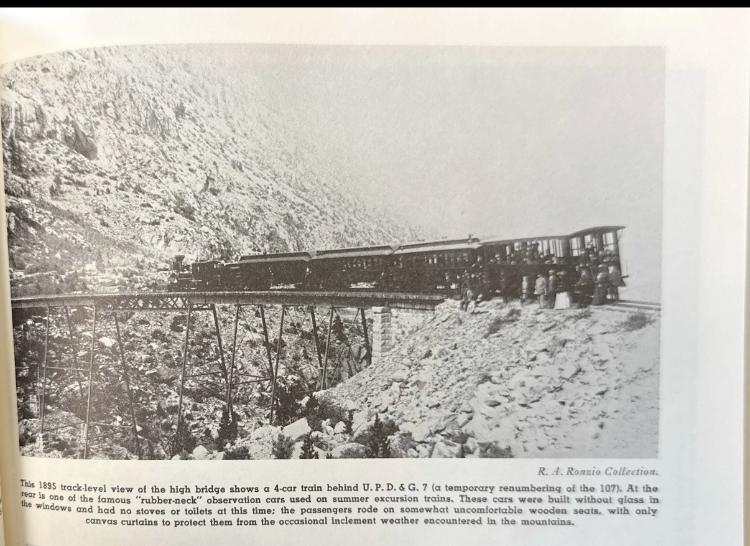 2. Is there any information available on what a typical passenger consist for the DSP&P might be? 3. I saw a photo, which I think was on this forum. However, I can’t locate it again. (Maybe I saw it in Poor’s book.). It is a photo of the rear end of a passenger train showing the platform with what appears to be a (whiskey-like) barrel on it. Someone is sitting on top of the barrel. Anyone recall that image? 4. Any ideas about this photo? That appears to be a colored female wearing a suit in the rear doorway, in the late 1800’s. I’m curious what that might be all about. (just realized this is a C&S photo from much later - but still intrigued) 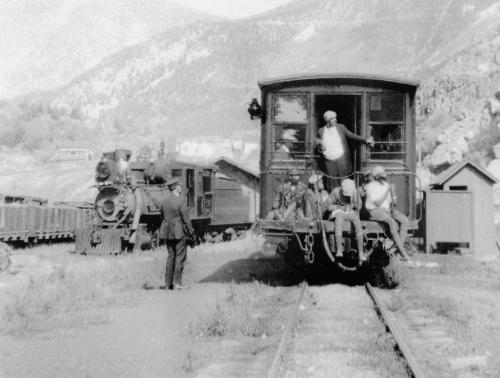 Thanks for any help? |
Re: DSP&P Passenger Car Research
Re: DSP&P Passenger Car Research
|
In reply to this post by Tundracamper
For information on the various groups of excursion cars, see:
https://www.midcontinent.org/rollingstock/CandS/cs_obs120-131.htm https://www.midcontinent.org/rollingstock/CandS/cc-passenger/excurs_13-18.htm https://www.midcontinent.org/rollingstock/CandS/cc-passenger/observ_139-148.htm As far as the photo of tourists having a "keg party" (likely a barrel of iced, bottled beer) on the rear of an excursion car:  Finally, the photo of a black church group on excursion up Clear Creek, taken at Silver Plume prior to return to Denver: 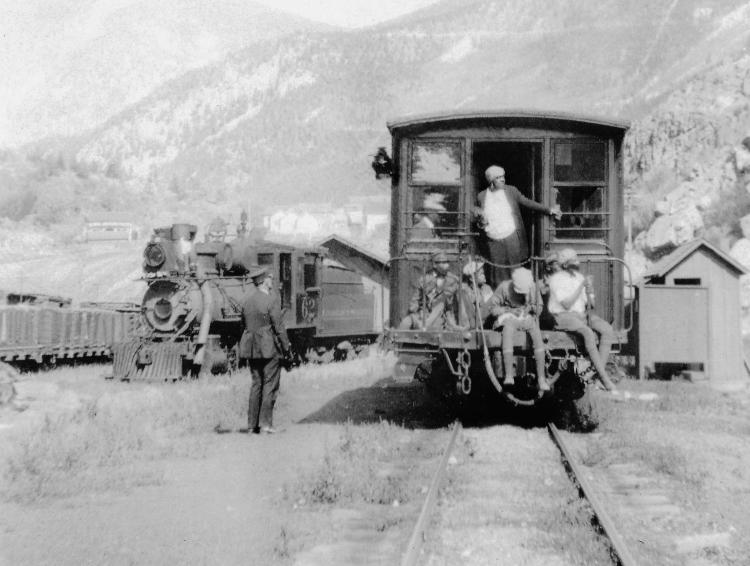 And see discussion: http://c-sng-discussion-forum.254.s1.nabble.com/Help-Identify-this-C-amp-S-Water-Tank-td3647.html#a3651
Jim Courtney
Poulsbo, WA |
Re: DSP&P Passenger Car Research
|
What fantastic info. Thanks so much. That photo from the rear came from another thread. That same one you provided was quite detailed. Thanks again!!
|
Re: DSP&P Passenger Car Research
|
In reply to this post by Jim Courtney
I must say, folks back in the late 1800’s and early 1900’s really seemed to enjoy themselves on train rides. I guess given that there were no cars or planes, that would make sense.
|
|
Administrator
|
Bear in mind that many, most, all of these photos are of excursions, on the Clear Creek Branch. So the consists are essentially a number of random coaches with one or two open observation cars. The locomotives used on these trains would be 2-6-0's and the length of these trains would be what you see in the pictures.
Standard consists for the regular daily passenger trains would include a Baggage and Mail car or a baggage car and maybe a single coach ot as many as two or three. Mixed trains might feature a combine behind a caboose. Excursion trains on the Mainline above Waterton were usually "Fish Trains" which would include a baggage car for gear and a number of coaches. These were not uncommon in the Platte Canyon District into the 30's. Passenger Trains on the Mainline generally included a Baggage and Mail Car if Mail was carried, or a Baggage Car or a Combine if not, and one or two coaches. So there are different types of consists depending on Mail or no Mail, time of year, or whatever other variables might be present. Obviously there are a lot of pictures of excursion trains mostly on the Clear Creek Branch because well, they were excursion trains. Hope this helps somewhat. |
Re: DSP&P Passenger Car Research
|
So now I’m going to ask some questions that will clearly demonstrate my ignorance and confusion on dates of mergers, etc…
You mention that most excursions were on the “Clear Creek Branch.” Wouldn’t that mean these photos were taken after the 1893 merger of the Colorado Central with the DL&G? Does that mean the DSP&P didn’t have any excursion cars and they were only added sometime after 1893 to the follow-on companies? When I see photos like the following, it makes me think DSP&P had excursion cars. However, I can’t find any detailed info on this image as the link in the post is no good, so perhaps I am just wishfully drawing a conclusion. Was this photo on the Clear Creek Branch as well? 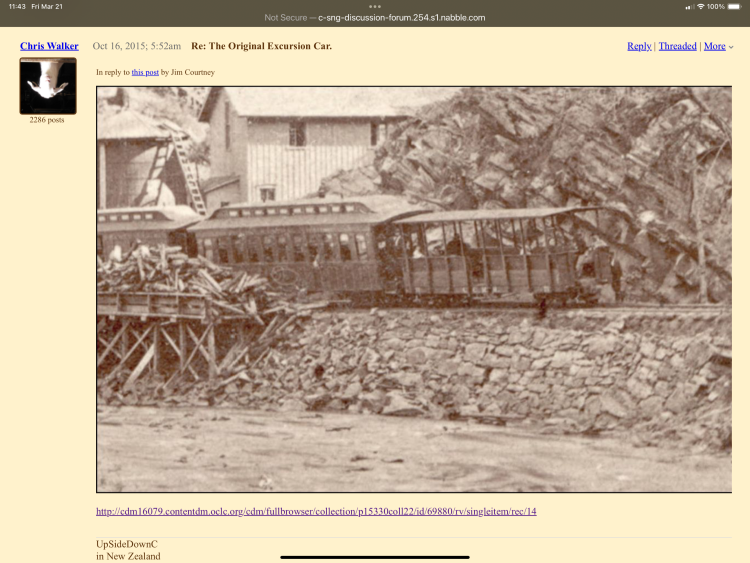
|
Re: DSP&P Passenger Car Research
|
This post was updated on .
Anon wrote: So now I’m going to ask some questions that will clearly demonstrate my ignorance and confusion on dates of mergers, etc…
Welcome to the club: this bothered me for years; learning about the differences between the predecessor Roads, and equipment that formed the C.&S. Rly seemed to take forever down here with little material accessible. In regards to the Excursion car above... This id is the latest iteration of the Denver Public Library link(they changed their system, negating a lot of my previous Post links: I now put the call number on the images I save). Gurnsey, B. H. (Byron H.), 1833-1880, Beaver Brook Station (1871-1880). Denver Public Library Digital Collections, Call number Z-3383, https://digital.denverlibrary.org/nodes/view/1108743 This image is taken, very early on the Colorado Central, at Beaver Brook. There is an image of the first train into Georgetown with an excursion car in 1887. That car resembles a converted Flatcar, and is not the same as the later ones. The Gilpin Tramway did the same. Looking in Sundance's Colorado Central Rail Road; lists the CC excursion cars as #13-#18; built 7/1883 by the U.P.(later UP1885 renumbered #820-825). At this time, I can't recall an early Excursion car image on the DSP&PRR. The Clear Creek line was an easy day trip for such runs. EDIT: There is a photo of an Excursion train at Morrison taken by H.H. Buckwalter in 1887(Mineral Belt Vol-II; pg16) showing four flatcar conversions(with lower half board sides) and with CCRR lettering, as the same in the Beaver Brook image. Mal Ferrell's South Park Line list of DSP&PRR passenger roster shows no reference to any Excursion cars. p.s.-EDIT: Just found my enlargement of the CCRR car at Beaver Brook, and it shows as # 5. The road initials are centred, but the cars at Morrison are not same. David S. Digerness, Mineral Belt Vol-II; pg16; Sundance Publications; 1978. 
UpSideDownC
in New Zealand |
Re: DSP&P Passenger Car Research
|
In reply to this post by Tundracamper
A small point: The DSP&P didn't merge with the Colorado Central in 1893. Now the longer story.
Once the South Park and Colorado Central were under full UP control in 1881/82 the use of equipment from each line on the other line became common. The UP viewed all equipment as under their control and thus moved equipment (engines, freight cars, passenger cars and non-revenue equipment) between its various subsidiaries, including other lines like the Utah & Northern and even the Nevada Central. By 1884 this was proving a headache because each line tended to have some car and engine numbering overlaps, which was a logistical nightmare. So in mid-1885 all equipment on the UP and its subsidiaries was renumbered, with cars and engines fitting into numbering slots assigned to each piece of the corporate collection. This cleared up things and the interchange and reallocation of equipment between the subsidiaries continued, which included not only moving equipment where the business needed it but also moving equipment from narrow gauge subsidiaries that were standard gauged to subsidiaries that were still narrow gauge (so U&N and KC cars ended up in Colorado). The UP was a financial disaster by the later 1880s and was reorganized starting in 1889 with the UP still in control of the receivership. The South Park parts became the DL&G, the CCRR parts were lumped in with a group of narrow and standard gauge lines to become a large organization with railroads stretching to Texas, the UPD&G. The UP continued to mis-manage the business and in 1893 local Colorado interests managed to wrest control of the DL&G and UPD&G (all the narrow and standard gauge parts) and put it into the hands of a new, local receiver, Frank Tumbull, in 1894. He turned the lines around and in 1898 brought the lines out of receivership and purchased by a new corporation that Trumbull led named the Colorado & Southern, which, like the UP managed all the lines and moved equipment between the various bits as necessary. In both the 1889 and 1893 receiverships, and even in the C&S takeover, the South Park parts were not the key interest as they had been money losers since at least 1883/84. The DL&G was under the control of the UPD&G in both cases and at both times the DL&G was a separate corporate entity from the UPD&G and there's some argument that in both cases there was interest in not including it at all. This also was considered when all was consolidated into the C&S. So no merger of these lines technically.
Dave Eggleston
Seattle, WA |
|
Administrator
|
In reply to this post by Tundracamper
Tundracamper, one thing that you will learn in pursuit of information with the South Park and CC, is that almost anything is possible, and there are few absolutes.
You may find some excursion trains on the Mainline above Waterton, but that would be unusual. Conversely, the C&S actively promoted Excursions on the Clear Creek Branch. It was convenient for a round trip in a single day, they could turn locomotives at Silver Plume, and they even converted a few locomotives to burn oil during the excursion season for the comparative comfort as opposed to cinders burning holes in umbrellas, etc.. And, the excursions did not interfere with traffic on the mainline. As I indicated yesterday, fish trains above Waterton were pretty common on weekends and even some holidays. But these trains, as far as I know, used only standard coaches. |
Re: DSP&P Passenger Car Research
|
In reply to this post by Dave Eggleston
Dave: would you consider an elaborated version of this most excellent summary and post it to the Timeline Sticky thread. Perhaps the moderators could parse it as the first post.
UpSideDownC
in New Zealand |
Re: DSP&P Passenger Car Research
|
This is all really excellent information. It’s one thing to list the dates, but these discussions are far more informative. Thanks for taking the time to post these.
|
|
I have found the excursion cars to be a neat subject. Building one of the longer ones is on my to do list once I get done with my current passenger car projects. I had started the one excursion car plan thread a while back asking about plans and since have gotten perhaps a bit more info and have been gathering a few unusual materials to start on them. I probably need to add on some to the thread there.
Jim Curran
|
Re: DSP&P Passenger Car Research
|
In reply to this post by Chris Walker
Chris, how does that work? Do I just write up something and post it or is there a group of forum luminaries who would take a look first? That last idea wouldn't be a bad thing, regardless.
I can elaborate on what I've written but feel this should be kept to a fairly tight, and conversational, summary. Is the timeline sticky the best place or should this become a new thread or should the good items in the sticky migrate to the files? I don't have any insight into the brave individuals who manage the backend of this forum and files, nor what is possible or reasonable and absolutely don't want to abuse them.
Dave Eggleston
Seattle, WA |
Re: Early CC RR flatcar conversions.
|
This post was updated on .
In reply to this post by drgwcs
I too found this a great refresher, and came to the realisation that those early CC RR flatcar conversions aren't listed previously in any of the books. I guess I'd never really given it much thought other than calling out the car at Beaver Brook. The earliest date I can put on one use of these is the 1878 completion into Central; were they around before then?
EDIT: One picture of the early CC RR excursion flatcar conversions in Colorado Central Rail Road (pg103) shows a double digit number. Note these were still in use at this time. 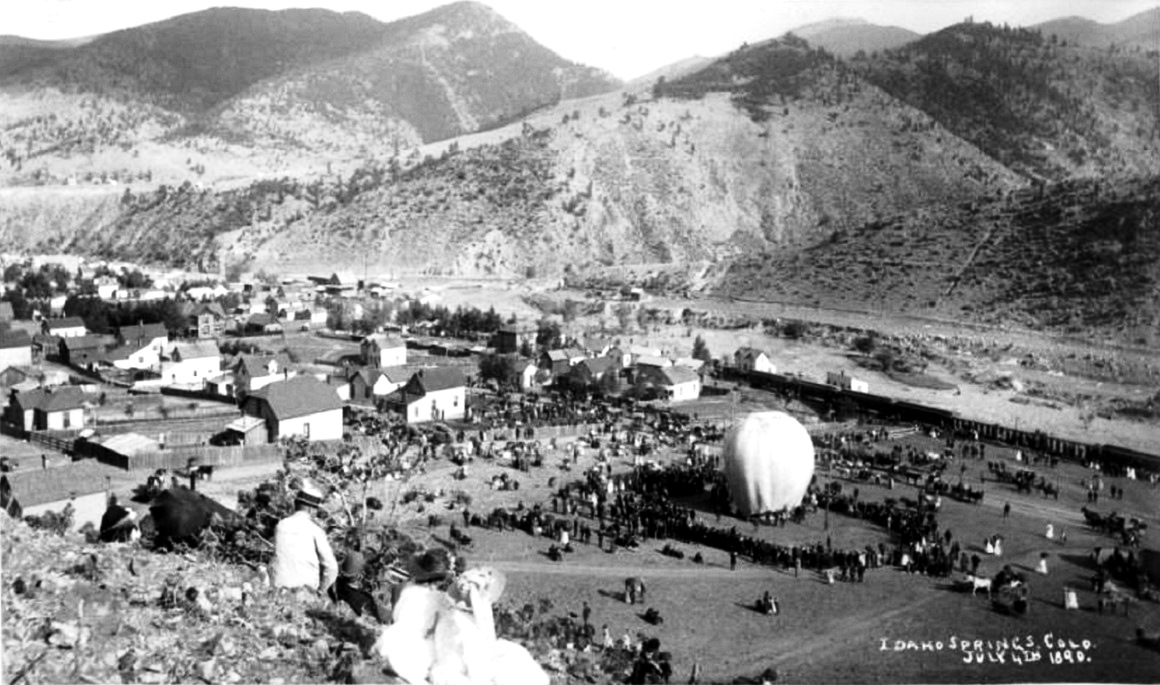
UpSideDownC
in New Zealand |
Re: Early CC RR flatcar conversions.
|
Well, even though I guess these weren’t likely used on the route via Apline, I know the owner of my DSP&P and when the outdoor Alpine route is constructed, some of those cars will run. The new owner just likes them too much. I’m toying with the idea of taking the LGB version I have and adding some shades to it. Unfortunately, I don’t have a place to do serious kitbashing right now and can only do minor mods that don’t involve painting. The shades seem like something simple to add - though I may then have a hybrid between the early flat-bed cars, which seem better matches for the LGB, and the later wooden cars with shades.
|
|
In reply to this post by Mike Trent
One thing is for sure: never say never!
I checked my Abridged Edition of the Pictorial Supplement and spied a photo of an excursion car, supposedly in Pitkin, on page 288. The photo is from 1885. The South Platte was popular with picnicers, and I swear there were weekend excursions to Dome Rock, which seem likely to have had an open excursion car on the end. These trains would have been in addition to the Fish Trains, which were flag-stop affairs that ran Denver to Grant in the morning and returned in the afternoon. Fish Trains were a coach and combination baggage car. The Denver-Leadville train was generally a coach and RPO, except for one period when the RPO ran Denver-Como and the RPO was traded for a single-door baggage car between Como and Leadville. This occured in the late-20s, as I recall. Once aware of some of these nuances--as Mr. Courtney is--you can better date a photograph.
Keith Hayes
Leadville in Sn3 |
Re: DSP&P Passenger Car Research
What a great find! I need to look through those images more carefully. The caption clearly states the trip was from St. Elmo over Alpine Pass. I would think it would have been pretty cool at that altitude in September. I can only imagine going thru that small tunnel, in the dark, with all the cinders swirling around. That clearly answers my question re: Alpine Tunnel and observation cars. I see that pages listed in the index under “excursion trains.” There are other images listed. It sure would be nice to have a fully digitized indexed list of all the images with full keywords! I would not have thought about “excursion” vs “observation.” Had anyone made such a list for this an Poor’s book? Sounds like a great use for AI, cross-referencing railroad terms and all:) Shame I have no clue how to do that. Page 3 shows at least four excursion cars at Morrison. Thanks!! |
Re: DSP&P Passenger Car Research
|
Ron Rudnick has a plan for CCRR #77 as an excursion car of the 1870s in his CCRR book, a converted flat with likely removable top. This is one of the earliest forms of covered excursion car on the line, prior to this a combination of coaches and flatcars with benches were not unknown, and possibly the form held until the UP control. It seems under UP ownership these cars became more "finalized" as seen in the Pitkin picture (in the original Pictorial it's on page 322).
With so little imagery or documentation we don't know fully what excursions looked at any given point or even division. I like to consider what was plausible, and here are a couple data points to think about: 1- The image is almost definitely 1882-1884--the engines all have Congdon stacks and passenger cars lettered appropriately for the period--the excursion car is lettered for the Colorado Central, not Union Pacific. 2- For much of the tunnel's active life (1882-1890 and 1894-1910) the line between St Elmo and Pitkin would be closed for 4-8 months, typically late Dec to late Spring. So excursions in most years occurred when snow and slides abated, or roughly between June and October. Weather could still be bad--cold and even wet. I've driven up to Breckenridge from Como in July and was caught in a snowstorm. I BET that people moved between the open and closed cars depending on weather and the need to smoke. 3- And then the reality inside the tunnel. Being in an open car through Alpine Tunnel was at best miserable, at worst fatal. Think about the stories of brakemen and enginemen crouched on the floors of the cab or low on car ends, wet cloth clutched over their faces to breath in the acrid, smoky space. Passenger cars were sealed up before going in. So, how about those folks on an open excursion, even with the curtains down? From these thoughts I can't help but suspect that while the open car carried passengers in the climb from St Elmo to Hancock or Atlantic, at that point the passengers were moved to the passenger cars for the trip through the tunnel. At Tunnel station they would be moved back outside. Same in the other direction. None of this negates having passengers, just expect your little people in the open car to be unconcious as they emerge from the tunnel... As to the image list you suggest, no. Poor's is but one source of images and not all captions are 100% accurate in the light of newer research. As to AI, I will plug doing the work yourself using an excel spreadsheet! You'll learn a ton by working through the images yourself and see connections you never imagined. Yes, more work but the benefits are so great.
Dave Eggleston
Seattle, WA |
Re: DSP&P Passenger Car Research
|
This post was updated on .
Dave Wrote: 1- The image is almost definitely 1882-1884--the engines all have Congdon stacks and passenger cars lettered appropriately for the period--the excursion car is lettered for the Colorado Central, not Union Pacific.
Thanks Dave: I noted the "new" Colorado Central Observation car in the Pict. Supt. were listed by Maxwell as 1883 built,edited out memory glitch in date. The Pitkin image(in the Pict. Supt.) (also printed with greater clarity in Dow Helmers Historic Alpine Tunnel), calls out the date as 6th Sept. 1885, and shows one of the "short end siding" cars. Just which version, we'll never know eh!  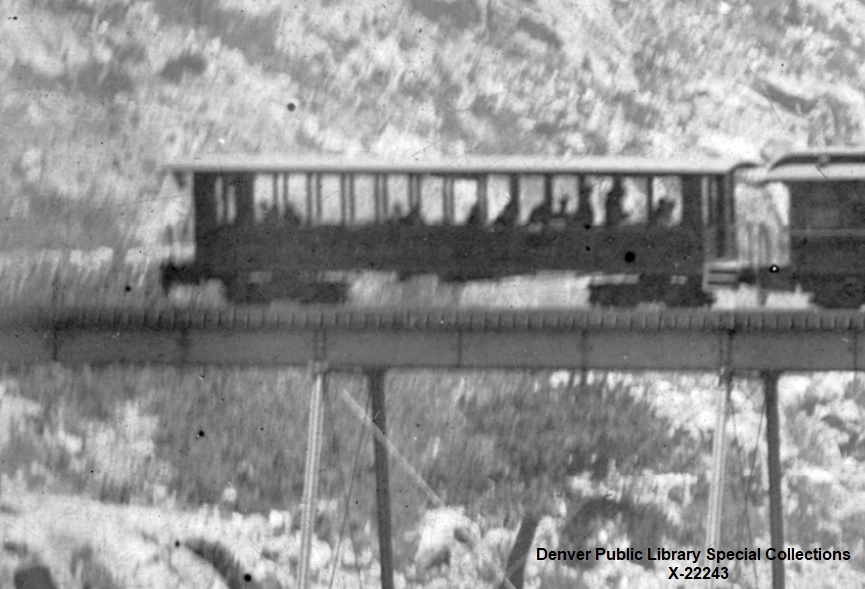 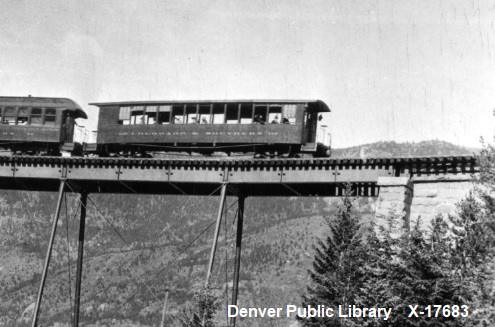 But if you lack one of the CC cars; use a Boxcar, replete with someone in the doorway. DPL Z-54 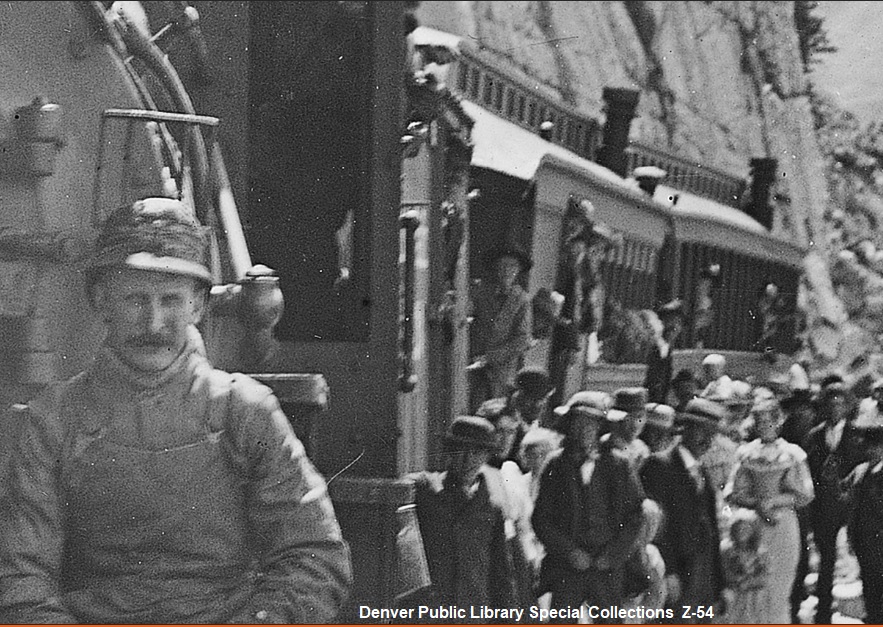
UpSideDownC
in New Zealand |
«
Return to C&Sng Discussion Forum
|
1 view|%1 views
| Free forum by Nabble | Edit this page |

